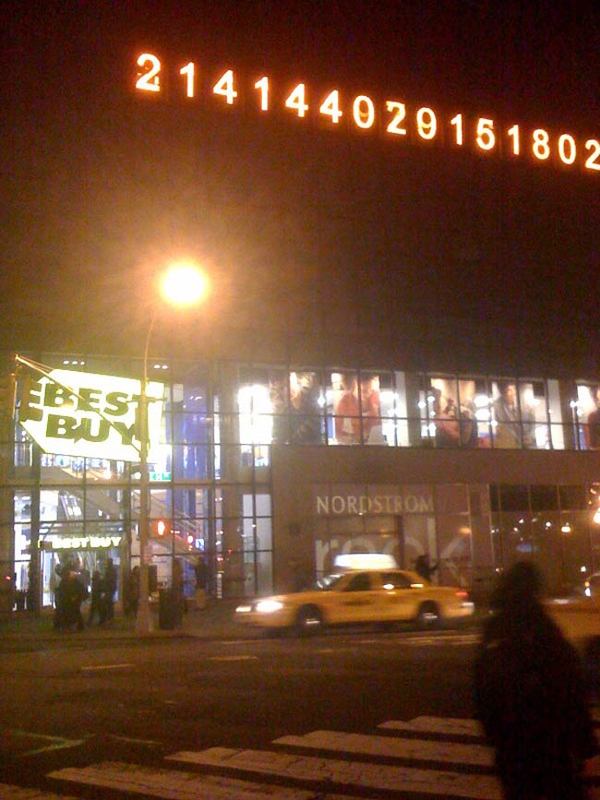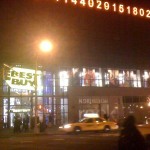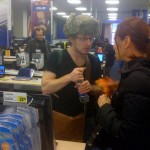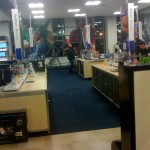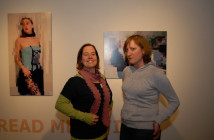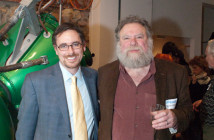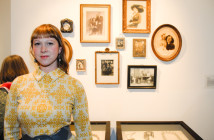There are certain places we have come to expect will be open 24 hours a day: gas stations, grocery stores, the occasional fast food restaurant. "Normal Business Hours" are an idea we left behind in the 90s, along with home phones and dial-up modems. Our productive hours of 'work' are increasingly creeping into our personal lives, and just as we are expected to be available at all times, we demand the same from the stores we patronize. They are only too happy to oblige our every impulse. Best Buy CEO Brian Dunn confirmed in a press release launching the 24 hour NYC store: “Today’s consumers have hectic lifestyles that don’t always conform to traditional retail hours.” Whether or not corporate motivations are as benevolent as they appear, we are now able to consumer any hour of the day. Perhaps that possibility makes us feel that we should be.
On Thursday, January 7th at 6 pm, Man Bartlett planned to spend 24 hours at Best Buy in Union Square. Entitled '24h Best non-Buy', I first came across the announcement of the piece on Art Fag City and that led me to a more extensive Tumblr post with more details from Man about the piece. He stated he would actively engage with the items in the store and the services provided, but not purchase anything. Also, he would only eat and drink what visitors provided him. This dependence invited participation and I felt a little obliged to bring something by, and frankly to see how long he could remain in the store.
I entered Best Buy deliberately browsing and trying to get a feel for what Man was experiencing. Best Buy is hypnotizing -- any giant box store seems like it's engineered to first bombard your senses with every conceivable product, and then lull you into a zombie-like state with overwhelming fluorescent lights and distraction. I was a little concerned I wouldn't be able to spot him, having just seen a tiny portrait on his website. Possibly, I was going to have to narrow down my search for him by approaching strangers. Man was not only defying the intention of the space for himself, he was also turning it into a meeting place for an anonymous audience connected only through his online social network. This seemed to actually work against the entire purpose of Twitter or Facebook, which promotes a voyeuristic compulsion to know what minutia your 'friends' are up to.
I had been following Man's extensive Twitter feed that evening and he mentioned that part of the piece was trying to find him in the store. I noticed a guy wearing a Russian fur hat and glasses, standing at a laptop display talking with someone. I made a few passes continuing to browse and subtly tried to glance over to see if it was just two friends talking. I noticed a few other people doing the same thing, watching, waiting to approach him and I figured this had to be Man. He told me later that the hat was an attempt to disguise himself, making the discovery of him a part of the experience.
After each post about an item he was looking at he added 'I will not buy'. I started to see the piece as an experiment in endurance and restraint, not unlike Chris Burden confining himself to a locker for 5 Days. This was another kind of self-control, actively fighting the very reason you are supposed to be in the space, to be continuously tempted by the promise of new products. We enter these spaces with one purpose: to buy something. Stores even hope to encourage you to buy something you had no intention to. Their sale advertisements are so good you're actually going to save money through buying. It's a not so subtle philosophy of just getting you in the store and keeping you there. Alec Baldwin's character in Glengarry Glen Ross says 'A man don't walk on the lot, lest he want to buy'. The things they sell are so fantastic you will be compelled to purchase them if you stick around. That's why Bed Bath and Beyond introduced a cafe. That's why IKEA serves breakfast and offers day care.
Man Bartlett was testing his own willpower against these ideas at his weakest, sleep deprived and hungry. In the face of all this research, he would remain in the store and not leave or buy anything under any circumstances. It was a consumer vision quest at a big box chain store. Obviously not without a sense of humor, especially in the twitter hashtag #BestnonBuy, and that he was using popular consumer technology to post throughout the process. But it wasn't entirely an anti-consumer judgement, or an inaccessible pretentious performance piece -- it was as much about sharing his personal experience as it was about not buying anything.
I visited Man Bartlett at his studio in Brooklyn to talk with him about the experience a few days after the performance:
JD: How did the idea for this piece originally come about?
MB:I had ideas for performance pieces similar to this for a few years, but didn't make them happen for one reason or another, but this one I just felt the time was right. I had the idea, I posted it to my blog and then I posted to Twitter, my Facebook. The only thing I used the computer for was to code an html email to my list. Everything else was managed on my phone. It came about from having the network in place, the people that followed me on Twitter and Facebook. The project was exciting from that standpoint, the technology was out there with social networking. I kept the idea simple and open enough it could kind of develop as it started.
JD: What was it about the Best Buy store specifically?
MB:You don't need anything at a place like Best Buy, we think that we do. One of my tweets was about that, 'What do you think that you need?' Not to be simplistic about it, but a lot of times I walk into a store like that and I might walk in browsing, but I come away with something that I don't need. I'm not coming out making a big anti-consumerism statement. I would leave that sort of commentary for other people. It's more of a personal experience about what it feels like emotionally. I think there's a specific irony in being in a Best Buy and not buying anything, but I think what interests me is being in one space for a certain amount of time and setting very simple parameters and seeing what happens.
JD: Did you want to approach the piece as a personal experience only? You mentioned you would only eat or drink what people brought you, but were you planning to interact with people who made the effort to stop by?
MB:I found it was counter-intuitive to ignore people who wanted to interact. But that also made it tricky to interact with people, keep up the Twitter feed, and to shop -- the balance of managing these three different components. On one hand you had the piece only existing on Twitter, on the other it existed only for the people who were there in person, and then on a personal level it only existed for me when I was interacting with the products. So shifting between those worlds was an interesting experiment.
I went in not knowing at all what to expect... if people would respond, if they were going to interact. I went in because I wanted to do it for myself with no real expectation of what the interaction would look like, if anyone was going to bring me food, I really didn't know. It was only 24 hours that I was going to be in the store, so if no one brought me anything, if no one came, it would be ok.
The piece could have existed without that interaction, but it would have been much different. That was one of the most exciting things for me is that people were getting involved, they were talking to each other, telling me what not to buy. I spoke to people after it was finished who said that Thursday night they didn't want to go to sleep, they felt engaged in what was going on. They felt guilty, they were aware that I was there and they were where they were.
The idea to rely on people came from a few places, but specifically from Waafal Bilal who did the piece 'Domestic Tension'. He set up a performance space so people could shoot him with a paint gun online. He relied on only what people brought to him in the gallery, and he stayed in that space for a month. I found that people were overwhelmingly happy to interact...I'm especially thankful for that coffee Friday morning.
JD: The people that stopped by then, were they mostly friends?
MB:I had this experience of not knowing if people were there to find me of if they were just shopping. There were a few times when different random people were coming at the same time, they were meeting each other and meeting me in this really bizarre way. Especially towards the end with the lights, the sounds and the commercials, just the overwhelming insanity of not having slept for 30 hours and what that does to the mind, let alone the interaction with people being in performance mode. The later it got into the piece, as it was sort of starting to wind down, people were coming in and I would have this impulse to keep shopping. I'd love to talk to you right now, but I need to shop. That was as much about meeting people who came to visit...I'm so grateful for everyone that brought food, and that showed up.
JD: How did just being in the store for that period of time effect you?
MB:The space itself was there operating nonstop for 24hrs. You had this cast of characters: the employees on their shifts, the customers, the security people and managers, all kinds of coming and going. At certain intervals the bathrooms might close for a little bit, but other than that it was nonstop. I became part of the building in some sense. I was a fixture there. It was an overwhelming sense of being a part of the architecture.
JD: Were there any points you were worried about completing the project?
MB:There were definitely moments in the middle of the night, but being able to post even though so few people were around at 4AM, it was nice to know that it was there, that there would be a timestamp on it. I'm here. I'm doing this. I will not buy anything. There were the hours before the security guards came where part of me wanted to get kicked out. I thought I really might not be able to do this. It was difficult emotionally at that point. To be in that space with your sleep patterns altered. I literally stayed engaged the entire time -- I wouldn't sit and do nothing, that was part of the piece: To literally shop, to look at these products the entire time.
Towards the end I asked myself what it would take for me to buy something. There were a few moments where I thought 'I could really use this thing', but for the most part I am actually ok not buying anything.
JD: You referenced Improv Everywhere in your post for the project, and there is an obvious element of humor in the piece, but what put this specifically in an art context for you?
MB:I take every action seriously even if it's 'fun', and I think that owes everything to my theater background which was about getting out there -- you are the art. The one thing that I felt disillusioned by in theater was this idea of walking in as an audience, you sit down, you see the play and then you go home. But at the same time I didn't like the performance art that was so inaccessible that it turned people off, so there's a very fine line. The context you can put it in can be very interesting and fun but it can also be about something a little bit bigger. It's the intention behind something. It's really not what, it's how, everything has been done before. I can't control perceptions of what people take away or what their reactions are to it. Which is why I went in to this very clearly with I'm doing this because I would like to do it. If no one shows up or contributes, it's fine with me. That makes it that much more gratifying when people do show up. I didn't expect the level of interaction I got. There were times when I said Twitter people I need your help, I am losing my mind, let's talk, help me through this so I can keep going. Along those lines it was really fun to watch the rise that happened throughout the 24 hours, where it really felt like there were a few people in the very beginning and by the end there was a pretty big crowd of people that were along. It built through this word of mouth of people posting, reposting, friends telling people to check it out. It's a nice way to get people involved...people that can't be there physically. The idea itself in one sense is the piece but for me another aspect is looking at 'ok well what can I take from it, how does it inform what I do next.' One form of that is having this document of what people were tweeting when it was going on.
Man Bartlett currently has a twitter feed for The Brooklyn Museum this month as part of their 1st fans art feed and is a Flux Factory artist in residence. His solo show of recent drawings and installations, Systema Mundi, opens at the Flux Factory, April 2nd. Sign up to receive emails about future duration pieces which are announced regularly at his Tumblr page.
All images are courtesy of the artist.

